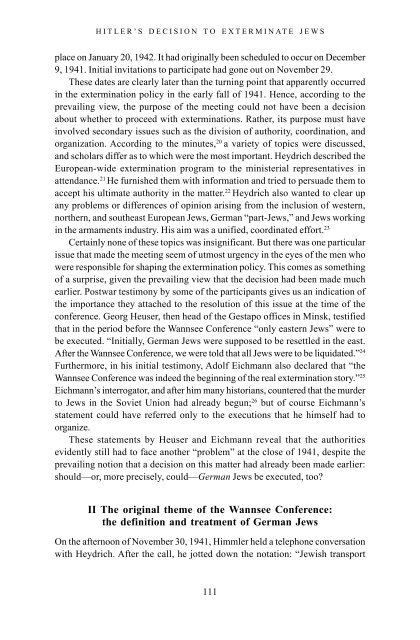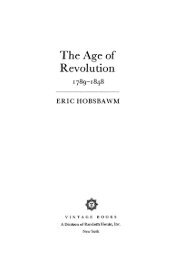The_Holokaust_-_origins,_implementation,_aftermath
The_Holokaust_-_origins,_implementation,_aftermath
The_Holokaust_-_origins,_implementation,_aftermath
You also want an ePaper? Increase the reach of your titles
YUMPU automatically turns print PDFs into web optimized ePapers that Google loves.
HITLER’S DECISION TO EXTERMINATE JEWS<br />
place on January 20, 1942. It had originally been scheduled to occur on December<br />
9, 1941. Initial invitations to participate had gone out on November 29.<br />
<strong>The</strong>se dates are clearly later than the turning point that apparently occurred<br />
in the extermination policy in the early fall of 1941. Hence, according to the<br />
prevailing view, the purpose of the meeting could not have been a decision<br />
about whether to proceed with exterminations. Rather, its purpose must have<br />
involved secondary issues such as the division of authority, coordination, and<br />
organization. According to the minutes, 20 a variety of topics were discussed,<br />
and scholars differ as to which were the most important. Heydrich described the<br />
European-wide extermination program to the ministerial representatives in<br />
attendance. 21 He furnished them with information and tried to persuade them to<br />
accept his ultimate authority in the matter. 22 Heydrich also wanted to clear up<br />
any problems or differences of opinion arising from the inclusion of western,<br />
northern, and southeast European Jews, German “part-Jews,” and Jews working<br />
in the armaments industry. His aim was a unified, coordinated effort. 23<br />
Certainly none of these topics was insignificant. But there was one particular<br />
issue that made the meeting seem of utmost urgency in the eyes of the men who<br />
were responsible for shaping the extermination policy. This comes as something<br />
of a surprise, given the prevailing view that the decision had been made much<br />
earlier. Postwar testimony by some of the participants gives us an indication of<br />
the importance they attached to the resolution of this issue at the time of the<br />
conference. Georg Heuser, then head of the Gestapo offices in Minsk, testified<br />
that in the period before the Wannsee Conference “only eastern Jews” were to<br />
be executed. “Initially, German Jews were supposed to be resettled in the east.<br />
After the Wannsee Conference, we were told that all Jews were to be liquidated.” 24<br />
Furthermore, in his initial testimony, Adolf Eichmann also declared that “the<br />
Wannsee Conference was indeed the beginning of the real extermination story.” 25<br />
Eichmann’s interrogator, and after him many historians, countered that the murder<br />
to Jews in the Soviet Union had already begun; 26 but of course Eichmann’s<br />
statement could have referred only to the executions that he himself had to<br />
organize.<br />
<strong>The</strong>se statements by Heuser and Eichmann reveal that the authorities<br />
evidently still had to face another “problem” at the close of 1941, despite the<br />
prevailing notion that a decision on this matter had already been made earlier:<br />
should—or, more precisely, could—German Jews be executed, too<br />
II <strong>The</strong> original theme of the Wannsee Conference:<br />
the definition and treatment of German Jews<br />
On the afternoon of November 30, 1941, Himmler held a telephone conversation<br />
with Heydrich. After the call, he jotted down the notation: “Jewish transport<br />
111



